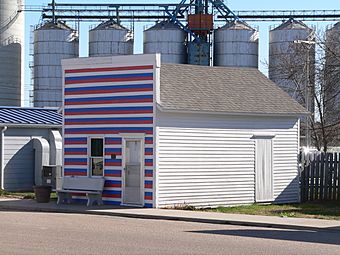Cahow Barber Shop facts for kids
Quick facts for kids |
|
|
Cahow Barber Shop
|
|

View from the northwest; photographed in 2009 after renovation.
|
|
| Location | SW Main St, Chapman, Nebraska |
|---|---|
| Built | 1889 |
| Architect | NA |
| Architectural style | False-Front Building |
| NRHP reference No. | 84002493 |
| Added to NRHP | January 12, 1984 |
The Cahow Barber Shop is a special building in Chapman, Nebraska. It was built way back in 1889. This building has a unique design called a false-front. This means the front wall is taller than the roof behind it, making the building look bigger and more impressive from the street.
The barber shop is made of wood and has a sloped roof. It is listed on the National Register of Historic Places. This means it's an important historical site. It's special because of its age, its cool design, and its connection to a famous author and photographer named Wright Morris.
Contents
A Look Back: The Cahow Barber Shop's Story
How It All Began
The Cahow Barber Shop was built in 1889. We don't know much about its early years. But in 1902, a man named Luther Cahow bought the shop. He was born in Stuart, Iowa. Mr. Cahow worked as a barber in this shop for 47 years! He finally sold it in 1949.
What Does It Look Like?
The building is a single-story, rectangular structure made of wood. It still has its original false-front design and a gable roof. The Lone Tree Literary Society has carefully restored the building. They made sure to keep its original parts, like the limestone foundation and the wooden siding.
The shop was built between May and December in 1889. It still stands in its original spot. Inside, it used to have two rooms, but the wall between them was removed to make one larger space. The front part of the inside was updated with new walls. However, the back part still has its original wooden panels and plaster. All three windows and three doors are also original!
The old items from the barber shop are no longer there. The original barber chair, mirror, clock, sink, and benches are now kept at the Merrick County Museum in Central City.
Why Is This Building Important?
The Cahow Barber Shop is important for a few big reasons. One of the most important is its link to Wright Morris. He was a famous author and photographer. The barber shop appears in his books and pictures. It's also where his father, William Henry Morris, first met his mother, Grace Osborn.
The building is also important for its architecture. It's one of the very few 19th-century false-front buildings left in Merrick County. This makes it a great example of how buildings looked a long time ago.



